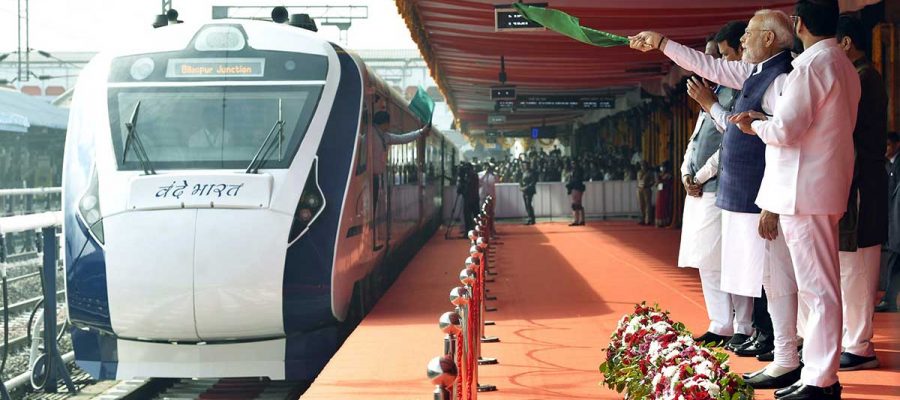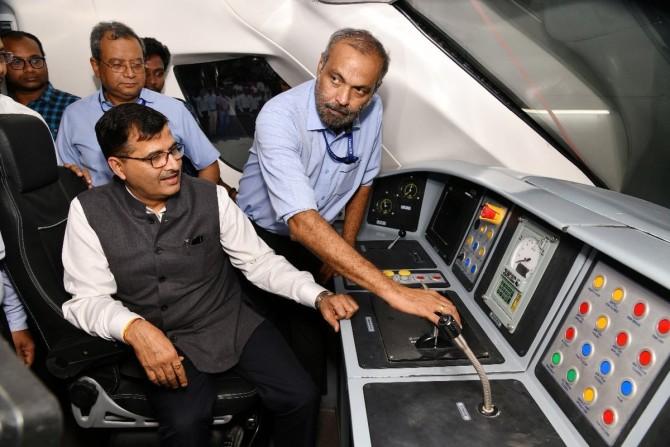‘All Shatabdis and Rajdhanis should be converted to this type of high-speed train.’
‘There should be a sleeper version of the train.’
‘Right now, there is only a day version of the train.’
‘Unless you develop a sleeper version, it will not be possible to replace the Rajdhani.’
‘Work on the sleeper version was stopped for some reason. It should be revived now.’
In December 2018, Train 18, India’s fastest train, a train that was built in 18 months, was flagged off from Chennai,
It is now known as the Vande Bharat Express.
The leader of the Train 18 Initiative was Sudhanshu Mani, the then general manager at the Integral Coach Factory, who retired in December 2018 soon after the train was launched.
Now that the government has announced ambitious plans for such high-speed trains, it was time to speak again to the father of the Vande Bharat Express.
“Infrastructure development has not kept pace with the development of the train. I know infra development needs greater effort, but we are far short of expectations. So, as of now, the tracks are still not suitable to exploit the full potential of the train,” Mani, tells Rediff.com‘s Shobha Warrier.
When we spoke in February 2019 soon after Train 18 had its first run, you had to tweet your number asking all the ‘doubting Thomases and trollers’ to call you. Now that the Vande Bharat express has had quite a few successful runs, do you feel vindicated?
Of course! Vindicated is not the correct word because we were never unsure about the train.
I had said then also that there was nothing wrong with the train.
Yes, apart from the Doubting Thomases, there were other negative elements which caused a period of lull, and these trains were not made. Now it is being regularly churned out from Chennai.
One feels good that so many trains are in the pipeline.
I remember you had talked about the train touching 180km/hour as the high point. Now that there are plans to run the Vande Bharat express connecting many cities, do you think our tracks are equipped to run such high-speed trains?
No. And that’s a little bit of a sour point.
When the development of this train happened, we knew we had to provide a future-ready train to run at 160-180 km/hour.
But infrastructure development has not kept pace with the development of the train. I know that infra development needs greater effort, but we are far short of expectations. So, as of now, the tracks are still not suitable to exploit the full potential of the train.
But I will hasten to add that even at lower speed operation at 130 kmph, it is of a great value as a fast and comfortable travel experience.
The speed at which the train runs now excels all the other trains on the section. It can accelerate and decelerate faster thereby cutting down travel time.
But it is a fact that the full potential of the train is not being exploited.
You feel upgrading the tracks should have gone together with the development and manufacturing of the train?
Yes. If not together, the development of infrastructure should have taken place at least in some sections so that the train could run to its full potential at 160-180 km/hour.
For example, the Delhi-Mumbai, Delhi-Howrah sections. Along these routes, there are many big cities, and they could also run inter-city trains at full potential. It should have been done at some sections gradually.
Yes, development and upgradation of infrastructure requires more resources and money compared to making trains.
But to support the train, simultaneous development of the infrastructure is necessary, and it has not happened so far, and one hopes that this picks up speed now.
Once the Vande Bharat Express started running, more than once, the train hit cows and other animals damaging the front of the train. Do you feel this is going to be one of the major problems it is going to face?
Let us understand this problem in the correct perspective.
Trains have a right of way on tracks with no allowance for trespassing human or cattle but increasing menace of cattle on tracks has socio-economic dimensions.
The division of fields has made the villages smaller and villagers may have fields split by a track or their housing on one side of the track and their field or grazing ground on the other.
The non-elevated tracks in Europe for semi-high-speed or above, are usually fenced. They also believe in public following the discipline of not trespassing and they do not have stray cattle which usually graze in a fenced enclosure.
In India, trainsets are new and unlike a locomotive, a passenger coach is in the front, just beyond the cab, and therefore safety of passengers has to be given greater thought.
Unlike the locomotives, the nose of a trainset cannot have an ugly cow-catcher, lest you kill its USP of aerodynamic profile and aesthetics.
The nose was designed using advanced computational flow dynamics tools for aerodynamics and its front structure, which supports the FRP (fibre-reinforced plastic) nose, is strong enough to withstand the impact of a cattle without any danger to the passengers.
The FRP nose gets damaged and sacrificed and its sections can be changed easily by the depot. It is a small price to pay till the Railways is able to solve the problem of cattle menace.
The train is meant for 160 kmph speed for which fencing is a requirement; if the infra has not kept pace with development of the train, the fault does not lie in its design, but slow upgrade of matching infrastructure.
As for mitigating the menace of cattle, once the track is made fit for 160 kmph operation, fencing would be a part of it. The Indian Railways should expedite the sanctioned works for upgradation to 160 kmph, and therefore fencing.
Simultaneously, the sections between two large cities which are less prone to incidents of cattle run over should be the first candidates. In any case, upgrades of sections on which Train 18 is likely to be run should be sanctioned.
A temporary but inexpensive fencing can also be installed quickly using scrapped concrete sleepers, which are otherwise useless.
At present, when more such trains are run on unfenced, unprepared tracks, there would be such occasions to bring bad name to the train.
More than bringing bad name to the train, don’t you think it is damaging the train causing additional expenditure?
Yes, it is a problem. The nose has been designed in such a way that if it gets damaged, it can be replaced without bringing any damage to the main train. In fact, the passengers and even the driver is safe even if the nose is damaged.
Yes, changing the nose is not a cheap option. It is pretty expensive and time consuming. Unless the train is run on fenced tracks, such incidents will take place and it is not good for the train.
In any case, ICF should study the design to modify it to make the nose sections more replacement-friendly.
What other changes are needed for India to have high speed trains like the Vande Bharat Express?
One is definitely the upgradation of the tracks.
Then, all Shatabdis and Rajdhanis should be converted to this type of high-speed train.
Third, there should be a sleeper version of the train. Right now, there is only a day version of the train. Unless you develop a sleeper version, it will not be possible to replace the Rajdhani.
Work on the sleeper version had started in 2018, but was stopped for some reason. It should be revived now.
If you start working today, by the middle of next year, you can have the prototype and get the sleeper version going. That’s something which is very necessary.
Because India is a huge country and people need overnight travel?
Yes. If you want to replace Rajdhanis, you need to have a sleeper version.
Feature Presentation: Ashish Narsale/Rediff.com
Source: Read Full Article










